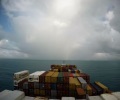

Ocean carriers took a raft of freight all-kind (FAK) and premium service increases on July 15, which pushed all-inclusive freight rates to new highs as shippers continued to compete for heavily constrained equipment and space.
“Going forward through September, [we’re seeing] increases of $500 to $1,000 every two weeks,” a US-based freight forwarder source said. “More importantly, ocean carriers are increasing premiums in their contracts.”
The source added that while carriers may offer a premium booking at a certain rate, shippers will bid one another higher until the final booking level is significantly above the initially quoted rate.
During the week, S&P Global Platts heard all-inclusive premium booking at $17,200/forty-foot equivalent unit (FEU) from China to USEC, finalized before July 15 increases.
A USWC Interior-Point-Intermodal (IPI) booking into Chicago was heard at $15,000/FEU.
Sources said that Aug. 1 rate hikes could make booking rates from Southern China ports increase above those in North China as exporting hubs in the Pearl River Delta grapple with renewed congestion.
“Four to six more weeks of catching up with backlog [at South China ports],” consultant Jon Monroe said July 15. “Expect major equipment problems.”
One freight forwarder expects ex-Shenzhen cargo to be at a $3,000/FEU premium to boxes leaving other China base ports from Aug. 1.
Short-haul and intra-Asia premiums more common
For Southeast Asia to North America trade lane, there was little change in the premium rates, which were heard at $18,000-$25,000 per FEU for East Coast North America and $17,000-$20,000 per FEU for West Coast. However, on the short-haul ex-Asia and intra-Asia routes, the premium rates became more widespread than before.
“Now there is a premium almost everywhere in Asia…the carriers are reluctant to take bookings for any destination except the US and Europe and everyone else is just struggling,” an India-based logistics provider said.
For India to US, the premium rates were as high as $2,000-$3,000 per FEU over and above the FAK rates and the total cost is around $14,000 per FEU for West Coast, a source based in Hong Kong said.
The rates for India to Australia were around $4,000 per TEU, including the premium of $1,250, a freight forwarder said, adding that even after paying the premium there is no certainty around bookings.
“I had a customer who had a shipment coming to Indonesia from Italy, he had paid the premium, but it was still stuck in Malaysia for three weeks,” a Singapore-based freight forwarder said. “The carrier said they could not find any connecting vessel … They have a lot of vessels, but they don’t want to enter the port due to congestion.”
Port congestion is a common sight even outside China and major ports in Southeast Asia and South Asia continued to struggle with omissions, booking cancellations and rollovers.
“It is a global phenomenon; the cascade effect can be seen at all ports. In the US, the congestion started with the West Coast, spread to East Coast and now even Vancouver port in Canada is facing challenges,” the Singapore-based source said.
Asia-Europe trade still operating on FAK basis
Limited movement was seen in the Asia-to-Europe container freight market over the course of the week, with rates remaining high and the same issues continuing to dog the market.
Expectations remained, however, that rates will increase in the short term as the market moves into typical peak season, and logistical constraints across East Asia have yet to ease following the coronavirus outbreak at the Port of Yantian.
Despite the expectation of further increases, carriers appeared unperturbed with increasing rates from their current all-time highs, with no General Rate Increases (GRIs) on the horizon for freight rates from Asia to Europe at this stage.
Even though bullish sentiment was prevailing in the market, and there were no GRIs, carriers were still opting to charge firmer FAK rates, rather than adopting wide-scale premiums as they are in other markets around the world.
Source: Platts